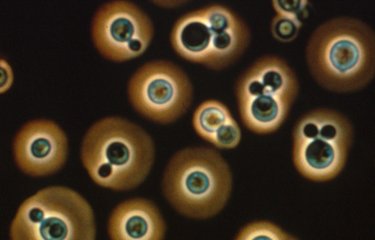Cryptococcosis ranks second among fatal opportunistic infections in patients infected by HIV and who are profoundly immunosuppressed. A multicentric prospective study, published today in PLoS Medicine, was conducted in France by researchers from the Institut Pasteur and the CNRS among patients diagnosed with cryptococcosis. The study uncovers parameters associated with more severe infections, such as the patient's sex and the infecting serotype. In light of the results, the authors propose a modification in the therapeutic treatment of individuals suffering from cryptococcosis.
Press release
Paris, febuary 6, 2007
Caused by a microscopic fungus, Cryptococcus neoformans, cryptococcosis affects immunosuppressed individuals, most of whom are infected by HIV, but who also suffer from other immunological disorders or who are receiving immunosuppressive treatments. Most often, the fungus causes meningoencephalitis, but the infection can also be localised in the lungs. The incidence of cryptococcosis in France has decreased by half with the availability of antiretroviral combination therapies, and now represents around 100 cases annually. However, in Africa and Asia, it remains the second most fatal opportunistic infection after tuberculosis in individuals infected by HIV, in some countries affecting up to 30% of them in the absence of access to antiretroviral drugs. It is now the first cause of meningitis among adults in Africa.
A vast cohort study was performed on patients diagnosed with cryptococcosis between 1997 and 2001 in France by Françoise Dromer, head of the Molecular Mycology unit (CNRS URA 3012) and National Reference Centre for Mycoses and Antifungals at the Institut Pasteur, and Olivier Lortholary, from the same Pasteur unit and the Necker-Pasteur Infectiology Centre, in collaboration with the French Cryptococcosis Study Group, which is composed of mycologists and clinicians in 77 centres throughout the territory.
Aiming to analyse the factors influencing the clinical presentation of the disease and its evolution (prognostic factors), this study enrolled 230 patients infected (HIV+) or not (HIV-) by HIV.
It demonstrates that the disease is more severe in men than women, suggesting influence of sex hormones. It is also more severe in HIV+ than in HIV- individuals. In terms of mortality, it is those patients suffering from a haematological malignancy (such as lymphoma or chronic leukaemia) in which cryptococcosis is the most serious. The study also demonstrates that between the two serotypes of C. neoformans present in France (A and D), serotype A is associated with a more severe presentation and evolution of the disease. Finally, the patients having neurological defects and/or abnormal consciousness, or abnormal neuroimaging at the time of diagnosis, have a worsened prognosis for survival.
Along with these different factors, the researchers studied the impact of the initial "fungal load" (the quantity of fungi in the organism) and the evolution of cryptococcosis according to the particular antifungal drugs used.
In light of all of the factors analysed, the authors advocate that all patients in whom a diagnosis of cryptococcosis has been established should have an assessment of their fungal load to evaluate the severity of the disease.
According to the researchers, this systematic assessment should include a cerebrospinal fluid culture, a blood culture, a urine culture, and a determination of the quantity (titration) of the circulating antigen of Cryptococcus.
"For patients who have a very high fungal load, we recommend starting an initial therapy combining two antifungals, a treatment that is currently only recommended in cases of meningitis and severe pneumonia", concludes Dromer.
The authors stress that the three-month mortality rate from cryptococcosis remains 15-20% in Western countries, and that this is much higher in Africa and Asia: this greatly justifies improving the therapeutic management of this disease in the future.
Sources
"Determinants of disease presentation and outcome during cryptococcosis : the cryptoA/D study": PLoS Medicine, February 6, 2007.
Françoise Dromer (1), Simone Mathoulin-Pélissier (2), Odile Launay (3), Olivier Lortholary (1,4), the French Cryptococcosis Study Group
1. Molecular Mycology Unit, Mycology and Antifungals National Reference Centre, CNRS URA 3012, Institut Pasteur, Paris
2. Institut Bergonié, Regional Cancer Centre of the Southwest, Bordeaux
3. Faculty of Medicine, Université Paris V, Cochin Hospital (Public Assistance-Paris Hospitals), Internal Medicine Department, Vaccinology Clinical Investigation Centre , Cochin-Pastuer, Paris
4. Faculty of Medicine, Université Paris V - Necker-Enfants Malades Hospital, Infectious and Tropical Diseases Department, Necker Infectiology Centre (Public Assistance-Paris Hospitals) - Pasteur, Paris
Contact persons
Institut Pasteur - Press Office
Nadine Peyrolo or Corinne Jamma
+33 (0)1 40 61 33 41
cjamma@pasteur.fr
CNRS - Press Office
Cécile Pérol
+33 (0)1 44 96 43 09
cecile.perol@cnrs-dir.fr





